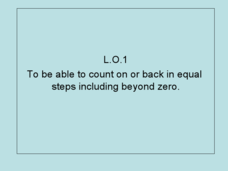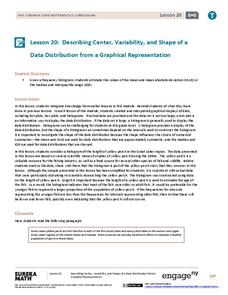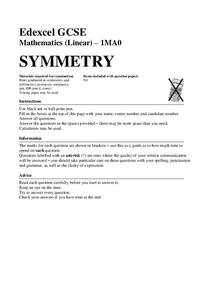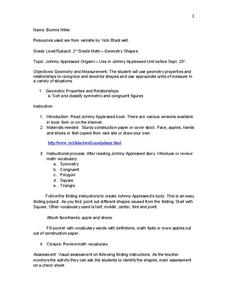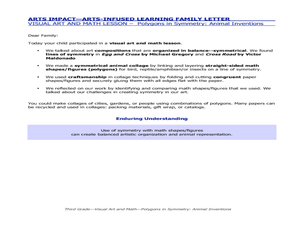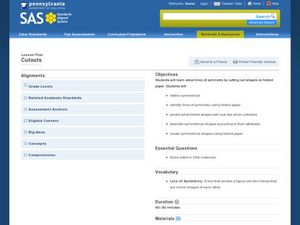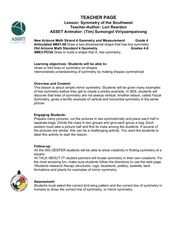Curated OER
Year 5 Unit D1
This presentation is intended to accompany an entire unit and covers a wide variety of concepts. Counting on, counting back, symmetry, properties of 2-D shapes, completing symmetrical patterns, and measuring angles are all covered.
Curated OER
Can You Name That Shape?
Learners use materials to build, investigate, and draw two-dimensional shapes (polygons). They combine the shapes they have built and draw from the pile to begin a round-robin activity to name and determine the attributes of a selection...
Curated OER
Common 2-D and 3-D Shapes
In this common 2-D and 3-D shapes worksheet, students define and solve 8 problems related to 2-D and 3-D figures as shown. First, they look at each 4-sided 2-D shapes listed and mark which ones always have the same angles. Then, students...
Curated OER
Symmetry and Geometric Shapes on Campus
Build on your learners' previous knowledge of geometric shapes and symmetrical figures. Then set them out to take photos of geometric shapes on campus. They assess whether the photos contain symmetry or not.
Curated OER
Castles On The Ground (2D & 3D Shapes)
Explore the relationship between 2D and 3D shapes by having your class view representation of shapes and investigate their symmetry. They will create a solid object from diagrams and describe the reflection or rotational symmetry. In the...
Teachers Network
A World of Symmetry: Math-Geometry
Define and identify the three basic forms of symmetry translation, rotation, and glides with your class. They cut out and arrange paper pattern blocks to illustrate symmetry, create a Cartesian graph, and design a rug with a symmetrical...
EngageNY
Describing Center, Variability, and Shape of a Data Distribution from a Graphical Representation
What is the typical length of a yellow perch? Pupils analyze a histogram of lengths for a sample of yellow perch from the Great Lakes. They determine which measures of center and variability are best to use based upon the shape of the...
Curated OER
Symmetry Using Polygons
Working on symmetry in your class? If so, this instructional activity might be for you. Learners observe different triangles and quadrilaterals, determine which are symmetrical, draw in the lines of symmetry, and color the symmetrical...
Curated OER
Symmetry Worksheet
This resource offers a series of hands-on activities in which learners sketch and construct symmetrical origami, paper dolls, snowflakes, and polyhedra while adhering to specific requirements. These activities ask class members to...
Mathed Up!
Symmetry
Eleven problems provide pupils the opportunity to find the lines of symmetry or identify rotational symmetry. Scholars alter designs to make them symmetrical, learn to recognize signs that are symmetrical, and identify the type of...
Curated OER
Hurricane Shapes: Spatial Patterns on Satellite Images
In this earth science learning exercise, students match 21 hurricane satellite images to their appropriate shape. They also answer 4 short answer questions about hurricane shape classification.
Curated OER
Johnny Appleseed Origami
Second graders make an origami Johnny Appleseed. In this geometry lesson students follow folding instructions. They find different geometric shapes while they are folding. They create Johnny Appleseed's body and attach a face and hands...
Curated OER
It's a 3-D World Out There!
Students construct polygons. They identify attributes of three-dimensional shapes. Students name common three-dimensional shapes. They draw three-dimensional shapes, and sort three-dimensional shapes. Students use K'NEX materials sets to...
Curated OER
Polygons in Symmetry: Animal Inventions
Fourth graders use polygons to create animal figures with symmetry. For this polygons and symmetry lesson, 4th graders create a symmetrical animal collage by cutting and gluing geometric shapes and figures from math activities.
Curated OER
A Wall of Symmetrical Shapes
Learners explore line(s) of symmetry in polygons during a hands-on activity and a Student Web Lesson. They build a wall of symmetrical shapes designed and drawn by students.
Curated OER
Cutting Positive and Negative SYMMETRICAL SHAPES
Young scholars cut intricate symmetrical shapes on the fold. Also, they identify positive and negative shapes and warm, cool and neutral colors. Finally, they glue shapes to create a pleasing design.
Curated OER
3rd Grade Math
In this math review worksheet, 3rd graders complete multiple choice questions about shapes, money, weight, and more. Students complete 20 questions.
Curated OER
Symmetry Worksheet IV
Challenge your class to identify, label, and draw a wide range of symmetries with this worksheet. In addition, learners name symmetrical shapes and compare them to alphabet letters. This worksheet asks class members to work with lines of...
Curated OER
Cutouts
Students identify symmetry in shapes. In this geometry instructional activity, students fold paper to identify lines of symmetry. Students create various symmetrical shapes using folded paper.
Curated OER
Reflections
Fifth graders create a reflection of a poygon using a Mira. They discover that a line connecting a vertiex of a polygon and the corresponding vertex of its reflection is perpendicular to the line of reflection. Students create a glide...
Curated OER
A World of Symmetry
Students identify lines of symmetry. In this symmetry lesson plan, students create objects and identify their lines of symmetry. They answer questions about lines of symmetry. Students cut shapes out of cookie dough and...
Curated OER
Symmetry of Road Signs
Students identify symmetry in road signs. In this geometry lesson, students explore objects in the real world for symmetry. They perform translation, rotation and reflection.
Curated OER
Symmetry of the Southwest
Fourth graders examine mirror symmetry. In this symmetry lesson, 4th graders discover that symmetry is not always vertical or horizontal. Students cut and fold shapes along lines of symmetry.
Curated OER
Lines of Symmetry
Do your learners know that letters of the alphabet have lines of symmetry? Well, some of them do. Scholars examine nine symmetrical letters and draw in the line of symmetry for each (one of them has two!). They also complete six letters...
